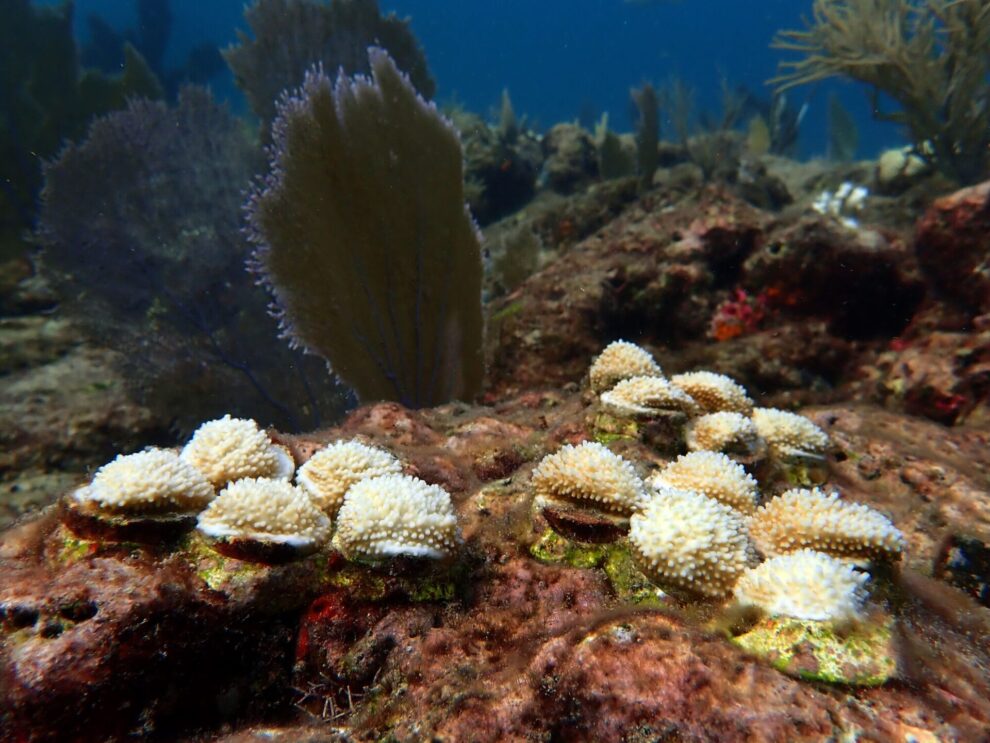Noaa and marine rescue groups work together in effort to preserve Florida’s reefs as rising water temperatures cause concern‘
A race is under way in Florida to rescue corals that are being bleached at alarming rates as a result of this summer’s historic heatwaves and rising water temperatures.
In recent months, marine rescue organizations and the National Oceanic and Atmospheric Administration (Noaa) have partnered to save coral and preserve Florida’s reefs amid record-high ocean temperatures and an earlier-than-usual mass bleaching event.
Since the late 1970s, the Florida Keys have undergone a 90% decline in healthy coral cover, a loss which experts have described as “unprecedented”. Several factors have accelerated the decline in healthy coral including rising water temperatures and acidity as a result of climate change, in addition to pollution, overfishing, storms and disease.
Noaa’s weekly coral bleaching heat stress outlook is at 90% probability, with the majority of southern Florida being placed under the alert level 1 where bleaching is expected. By September, southern Florida is expected to be placed under alert level 2, the highest level, where widespread bleaching and some mortality is expected.
One of the main reasons behind Florida’s current mass bleaching event – which is usually expected around late August and September – is record temperatures that have been arriving earlier in the year, warming the ocean significantly.
Reef-building coral is unable to tolerate water temperatures below 64F, according to the Noaa. Many grow optimally in temperatures between 73 and 84F.
“We expect reef temperatures in July to be 84-86F but many of our colleagues have reported 88-91F temperatures this month. July is incredibly early to be seeing these temperatures on our reefs,” Cynthia Lewis, the director of the Keys Marine Lab at Florida’s Institute of Oceanography, told the Guardian.
On July 24, the Manatee Bay buoy in the Florida Keys measured an ocean water temperature of an astonishing 101.19F. The record high temperature, which is commonly found in hot tubs, has left weather and marine experts deeply concerned.
Prior to this year’s mass bleaching event, the Florida Keys saw such high temperatures during the summer of 2014 that another widespread bleaching event was triggered. Over a third of elkhorn corals – one of the region’s major reef-building coral species – in seven Noaa monitoring sites across the Upper Keys were either damaged or killed.
A 2022 study found that the Florida Keys, particularly along the southern island coasts, “revealed very strong increasing trends” of marine heatwaves over the years, adding that the detected positive trends and “especially the recent high peaks of MHW events, may enhance the loss of specific heat-sensitive species, damaging the biodiversity of this tropical coastal environment”.
Earlier this month, the Coral Restoration Foundation visited the Sombrero reef in the Florida Keys, a restoration site that the foundation has been working at for over a decade. “What we found was unimaginable – 100% coral mortality,” Phanor Montoya-Maya, CRF’s restoration program manager, said in a statement.
“We have also lost almost all the corals in the Looe Key Nursery in the Lower Keys. Yet we remain hopeful and determined. Sites in the Upper Keys, where the water is cooler, are not yet showing such dramatic declines, which gives us time to act,” he said.
The mass bleaching event in Florida stems from a symbiotic relationship between coral and an algae known as zooxanthellae that is accelerated by hot waters.
Andrew Baker, a marine biology and ecology professor at the University of Miami, told the Guardian: “Corals are animals. They create underwater forests … that are stuck to the seafloor in the world’s shallow tropical seas. The reason they’re able to build these forests is they have these tiny algal partners that live inside them and photosynthesize and turn sunlight energy into food.
“Unfortunately, that sort of special superpower that they have, which is this partnership with the algae, is also their Achilles heel, because the algae are very heat sensitive. And what happens when the corals get too hot is the algae, instead of producing food for the coral host, end up producing toxins and these toxins trigger a response out of the coral that causes the coral to try to get rid of the symbionts, the algae, as quickly as possible.
“When corals get heat stressed, they turn white as they get rid of their algae in this process that we call coral bleaching. A bleached coral is not a dead coral but it’s a severely weakened coral … And that’s the concern that everyone has right now, which is that these corals are already so bleached that many of them will go on to die.”
In an attempt to recover Florida’s coral, the Noaa launched Mission: Iconic Reefs, a widespread project involving various partners aimed at restoring seven key reefs to self-sustaining levels by 2040.
As part of the recovery efforts, the Coral Restoration Foundation is rescuing as many corals as possible from its nurseries and relocating key genotypes to land-based holding systems to “safeguard our broodstock,” which Montoya-Maya said are potentially the last lifeline.
“Given the severity of this event, our immediate focus is on the rescue mission at hand. We are concentrating on preserving and protecting as much of the genetic diversity of our reefs as possible,” Montoya-Maya said.
So far, CRF has rescued 417 of its elkhorn and staghorn corals and has helped to safeguard around 350 genotypes of these coral species. The foundation has also saved an additional 484 corals across other species, CRF announced in a press release.
Similarly, Lewis, who heads the Keys Marine Lab, told the Guardian that KML’s restoration partners have already brought over 1,500 to 2,000 pieces of coral and multiple species to KML for safekeeping. KML currently serves as a refuge for the rescued corals by providing cooler-temperature controlled water in its seawater tables.
“Some have transitioned through KML to other land-based nurseries around Florida so we don’t have all our eggs in one basket. A few of our nursery partners will continue to bring more corals in the coming weeks, perhaps doubling or even tripling that number. The challenge will be to allow them to recover and remain healthy until they can be returned to the nurseries to regrow and outplant,” said Lewis.
“All of the many coral restoration practitioners are working to identify and breed more resistant and resilient corals for the future, meanwhile growing and outplanting many species of corals already growing in their nurseries to preserve the reefs we still have,” she added.
The impact of Florida’s coral wellbeing extends far beyond just allowing other marine life to thrive in an already deeply interconnected ecosystem. Each year, Florida’s coral reef, which stretches over 350 miles, supports over 71,000 full and part-time jobs. Moreover, the reef generates over $6.3bn in combined local sales and income associated with snorkeling, scuba diving, fishing and other tourism activities.
Perhaps most importantly, the coral reef also acts as a buffer to the Florida coastline during storms, an extreme weather event occurring more frequently as another catastrophic result of climate change.
“The actual physical structures that are built by corals underwater … contribute to protecting our coastal islands from the damaging effects of storms. Corals and other associated ecosystems actually are now recognized to be worth hundreds of millions of dollars a year in avoided damages … just in a normal year, not even in a storm year,” said Baker.
As rescuers race to preserve Florida’s coral reef, experts warn that such efforts will not be enough if climate change is not addressed as a whole in a multilateral effort.
CRF’s chief executive Scott Winters said: “There is still time to intervene, but our window for action is rapidly closing. To save coral reefs, we must mitigate the effects of climate change, preserve the corals and coral reefs that we have, and engage in restoration to rebuild remnant populations and their genetic diversity so that coral reefs can evolve to meet changing climate conditions.
“Each of these actions will be necessary; any one of these actions, in isolation, will be insufficient.”
Source: The Guardian















